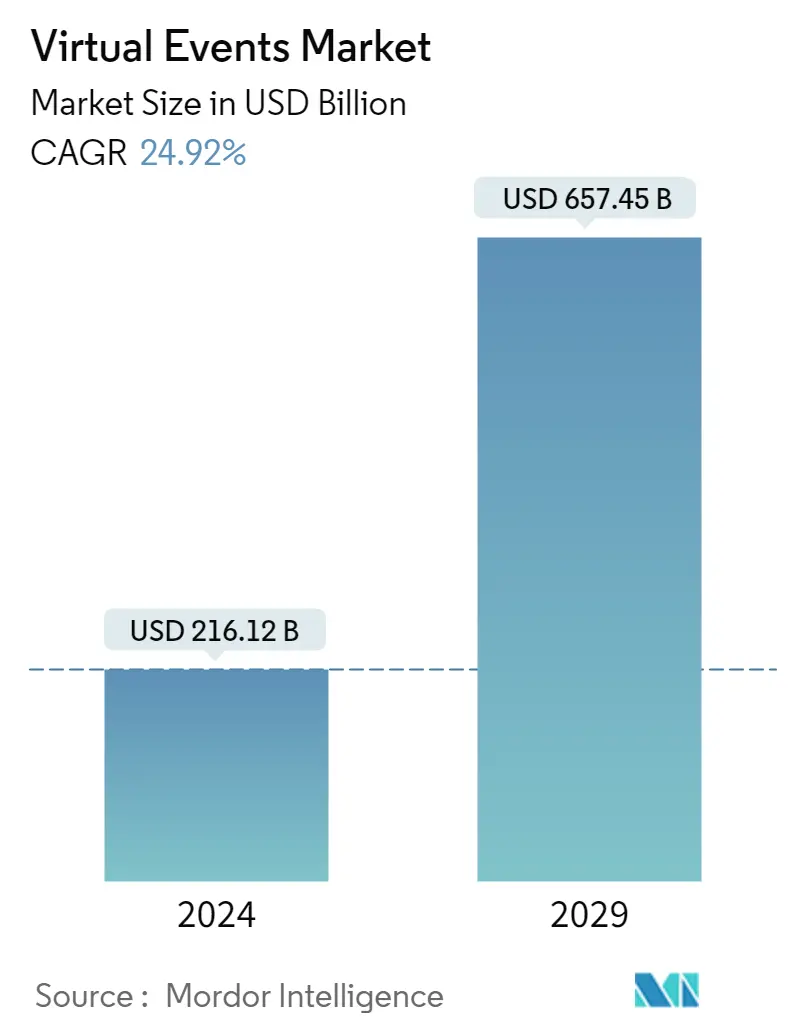Market Size of Virtual Events Industry

| Study Period | 2019 - 2029 |
| Market Size (2024) | USD 216.12 Billion |
| Market Size (2029) | USD 657.45 Billion |
| CAGR (2024 - 2029) | 24.92 % |
| Fastest Growing Market | Asia Pacific |
| Largest Market | North America |
Major Players
*Disclaimer: Major Players sorted in no particular order |
Need a report that reflects how COVID-19 has impacted this market and its growth?
Virtual Events Market Analysis
The Virtual Events Market size is estimated at USD 216.12 billion in 2024, and is expected to reach USD 657.45 billion by 2029, growing at a CAGR of 24.92% during the forecast period (2024-2029).
The concept of hybrid events, which combine physical and virtual elements, has gained popularity. This trend may continue to drive the virtual events market as organizations seek to reach a wider audience by simultaneously offering in-person and online experiences.
- Virtual events provide convenience and flexibility for both organizers and participants. Attendees can join from the comfort of their homes or offices, eliminating the need to spend time and effort on travel arrangements. Virtual events also offer the ability to watch recordings or access materials on demand, allowing participants to engage at their own pace.
- The increasing adoption of Unified Communication as a Service (UCaaS)-based solutions by various organizations and enterprises, including academic institutions, has allowed employees and other resources to virtually engage with all the business proceedings and help in realizing a more efficient and effective workflow, which bodes well for market growth.
- The convergence of modern technologies such as artificial intelligence (AI), augmented reality (AR), and virtual reality (VR) is further complementing online communication and collaborative activities to compensate for all the aspects of a physically organized event. Further, companies are rapidly adopting virtual simulation platforms to effectively manage time and resources, driving the market's growth.
- However, virtual events rely heavily on technology infrastructure, including stable internet connections, streaming platforms, and collaboration tools. Technical issues such as connectivity problems, bandwidth limitations, software glitches, or compatibility issues can impact the user experience and hinder the adoption of virtual events.
- The COVID-19 pandemic had a positive impact on the events industry. With restrictions on large gatherings and travel limitations, organizations quickly shifted to virtual events as an alternative. The pandemic accelerated the adoption and acceptance of virtual events as a viable solution, and this trend is expected to continue even as the situation improves.
- Additionally, the Work-From-Home (WFH) policy was adopted as a workaround by several companies in response to the lockdowns and restrictions on the movement of people imposed by various governments across the world as part of the efforts to arrest the spread of the coronavirus and has emerged as one of the major factors driving the market. At this juncture, virtual events are decisive in allowing businesses to connect with the remote workforce and conduct business procedures.
